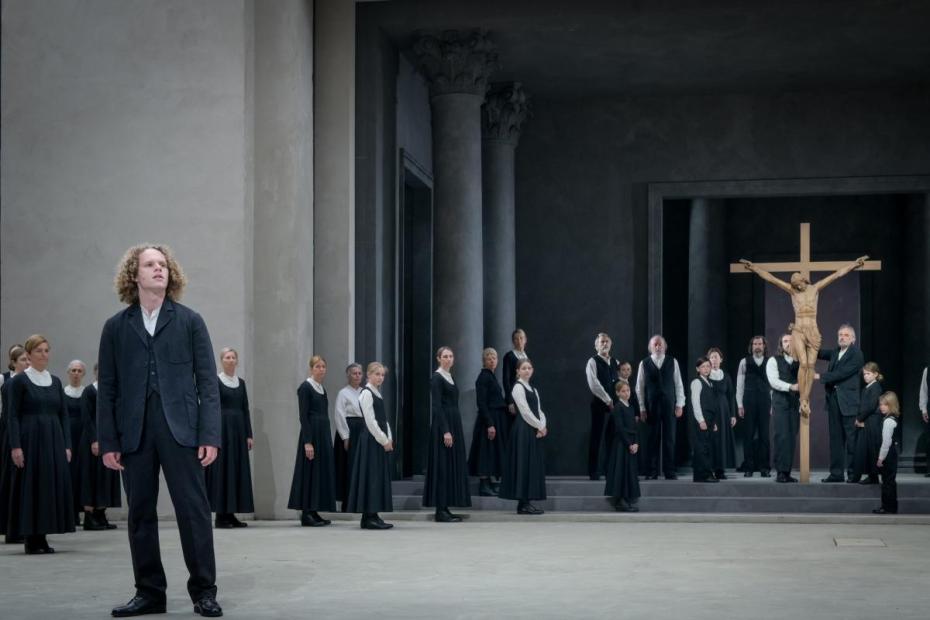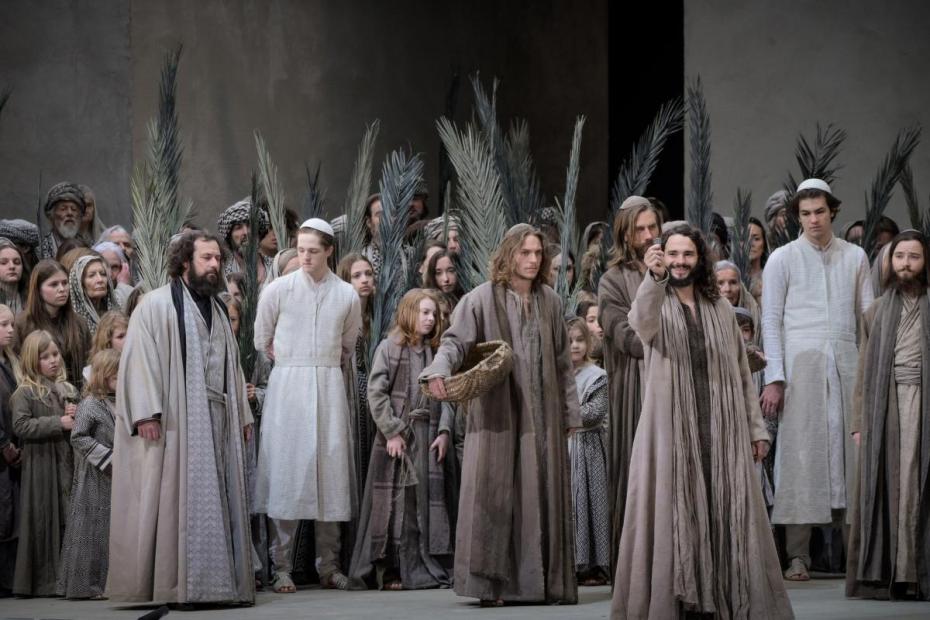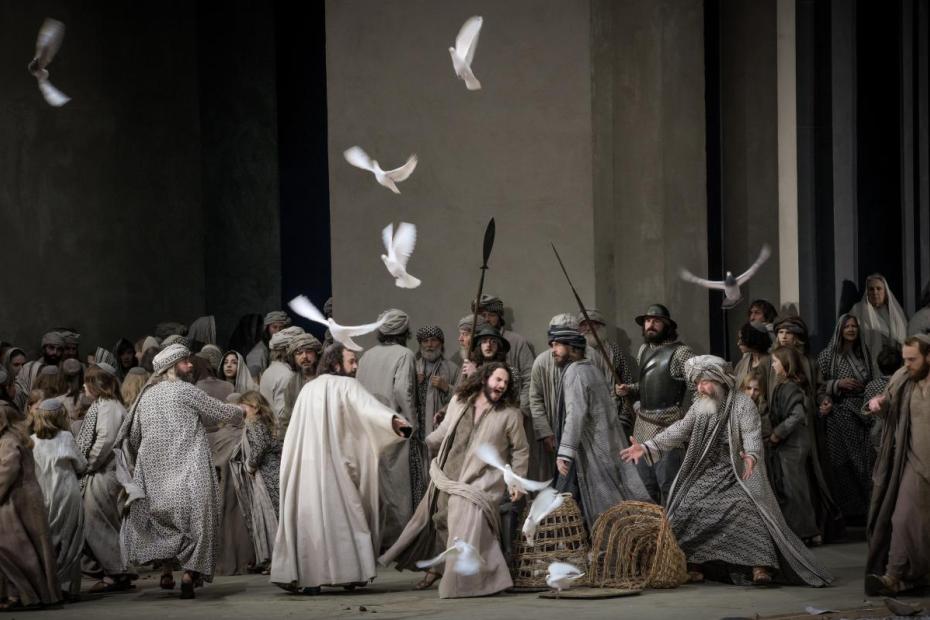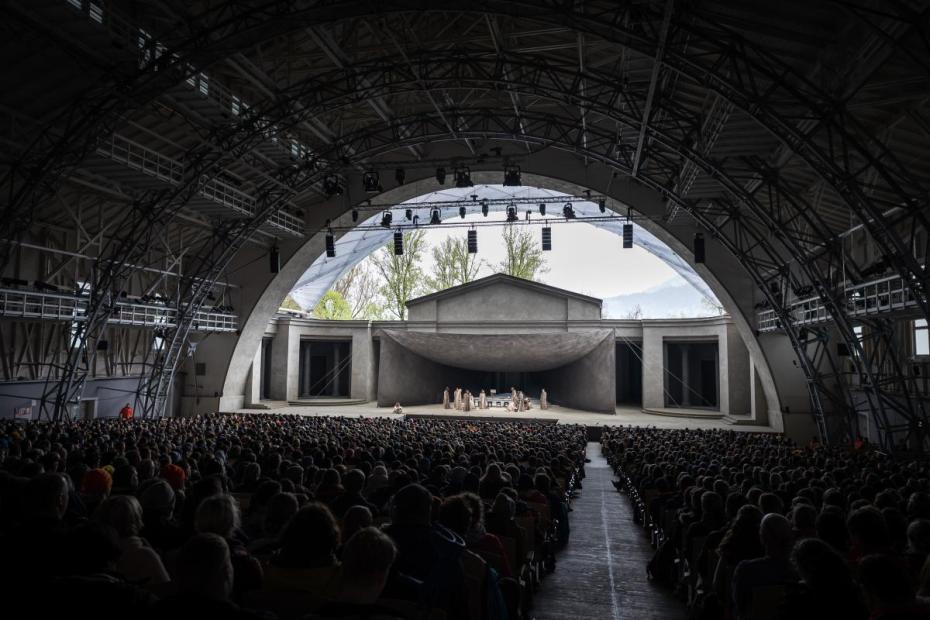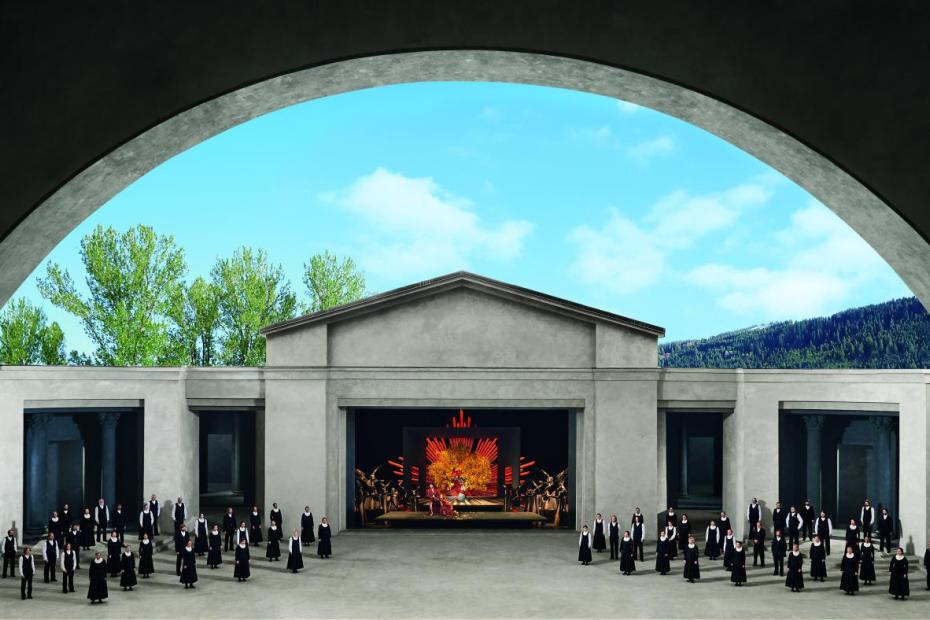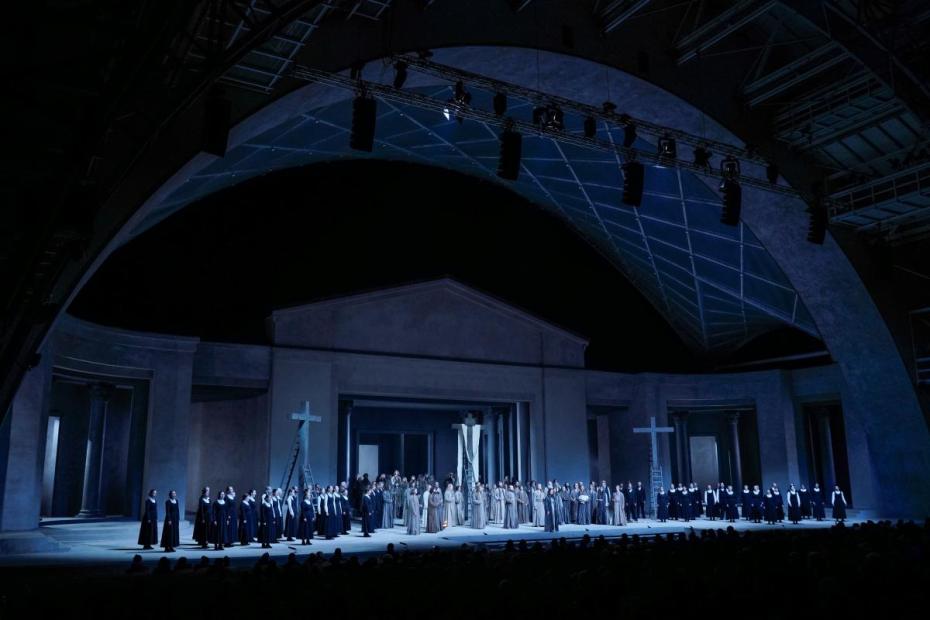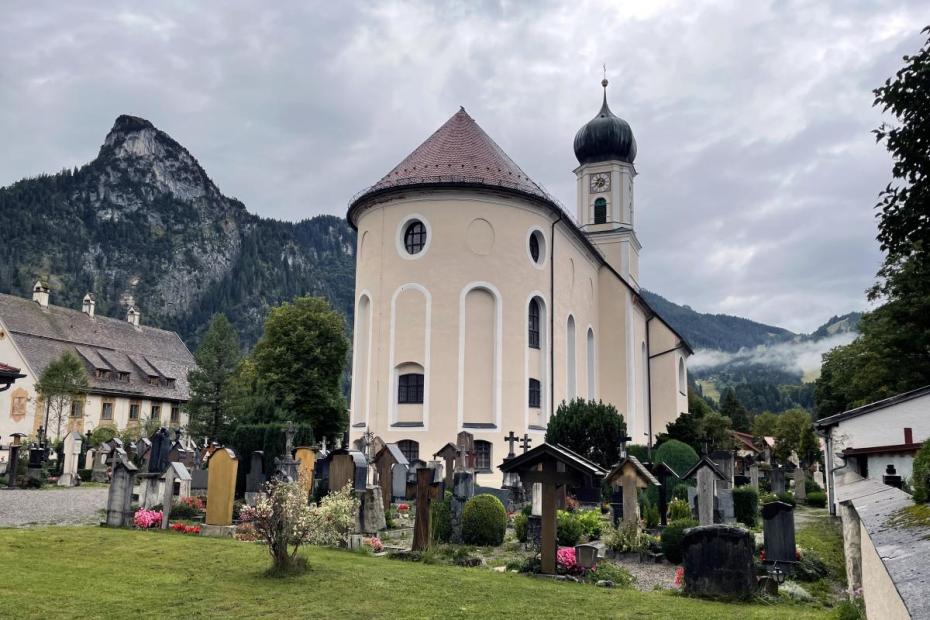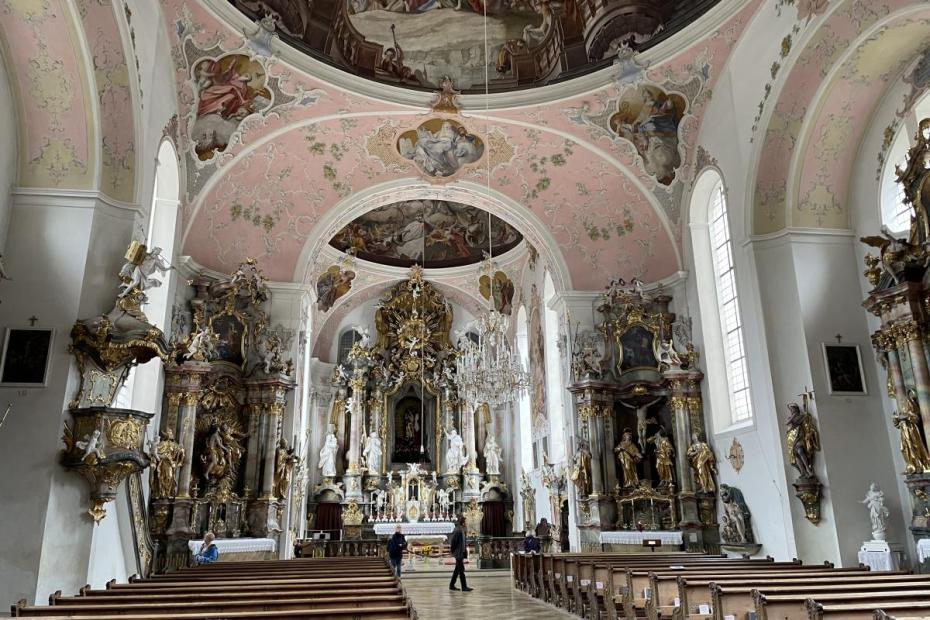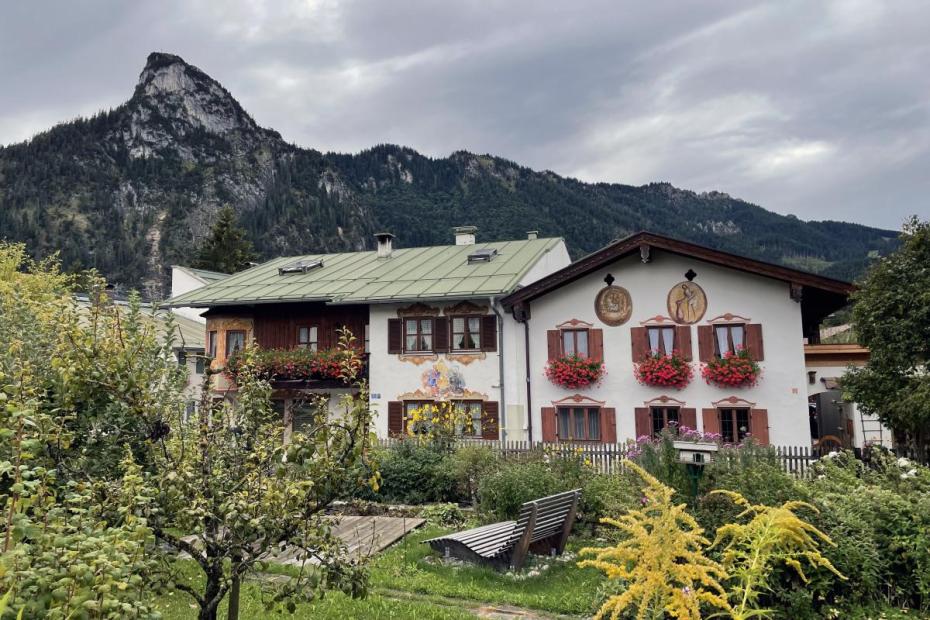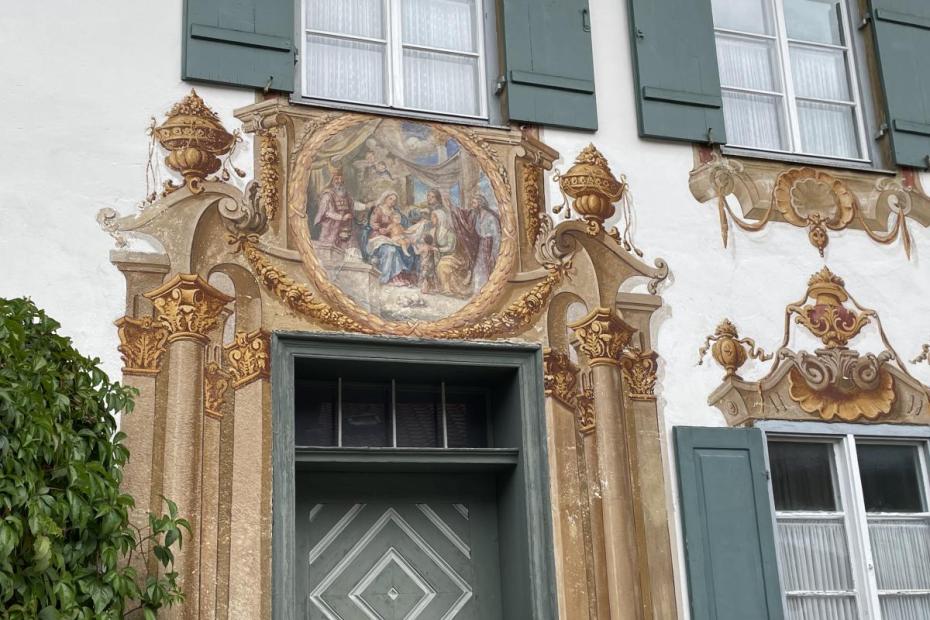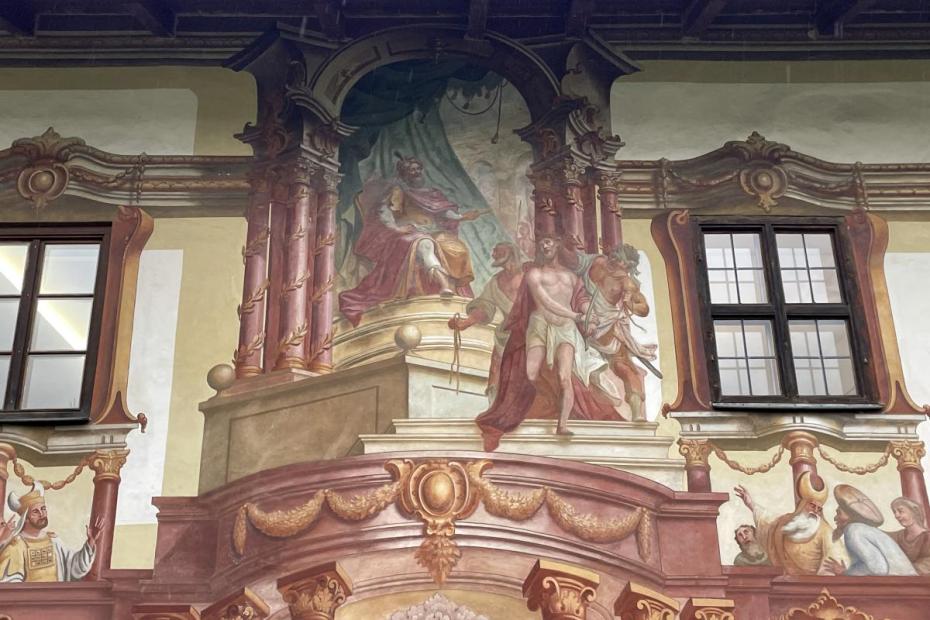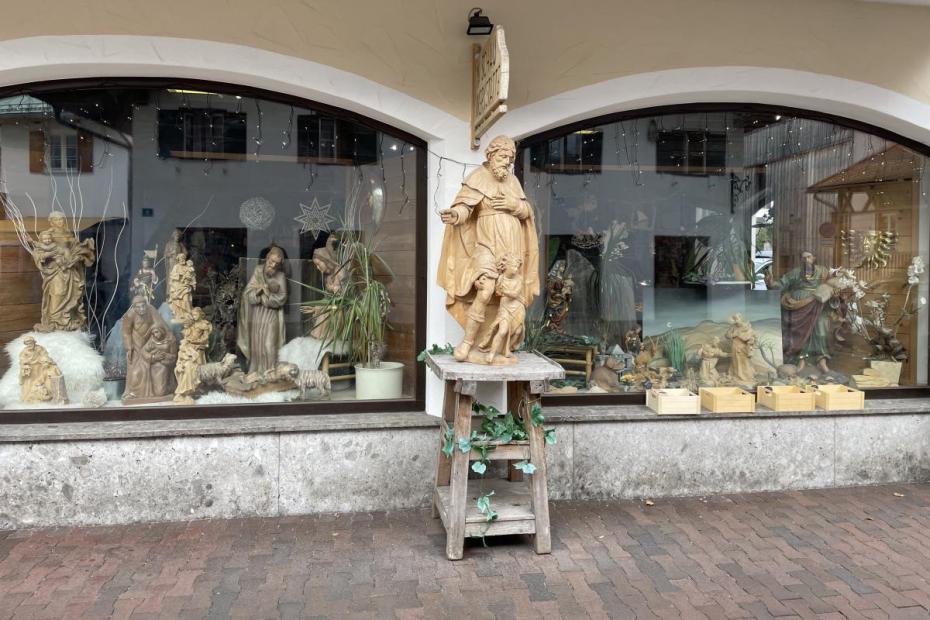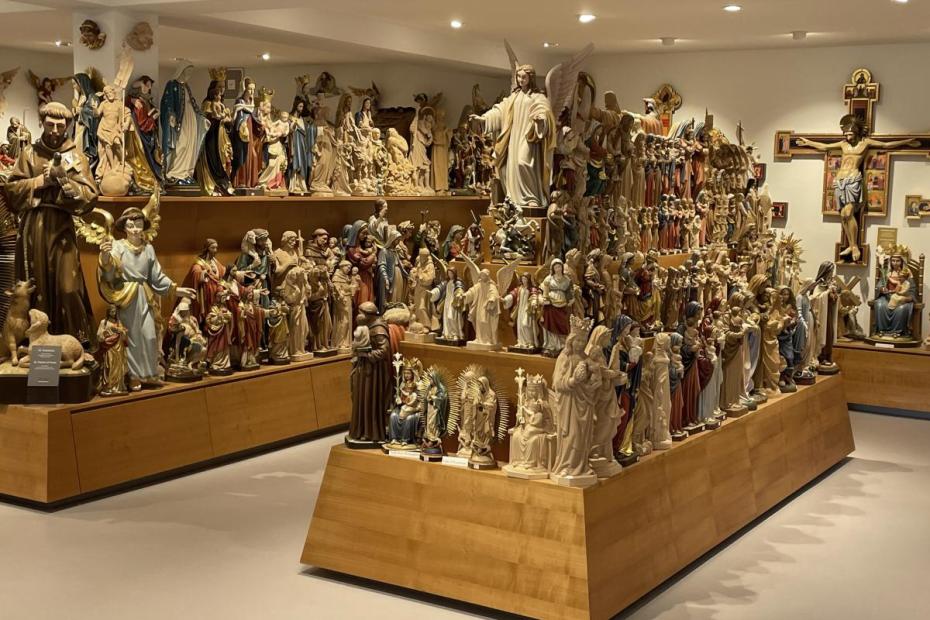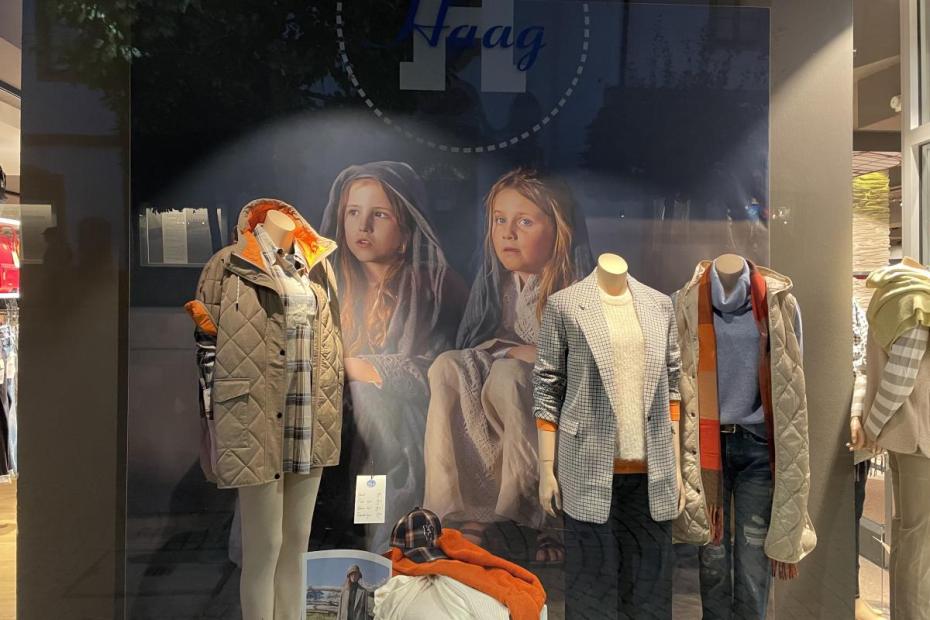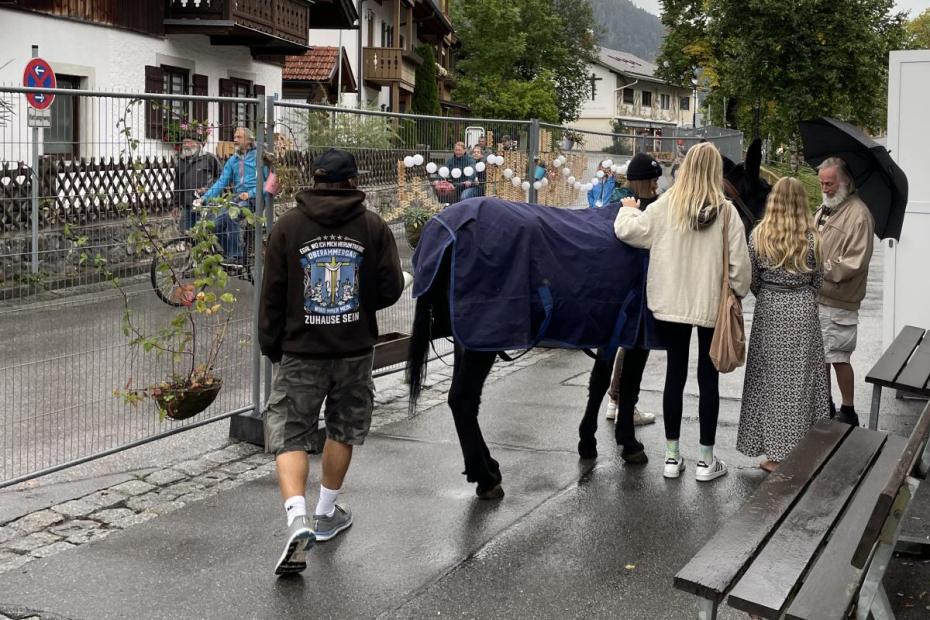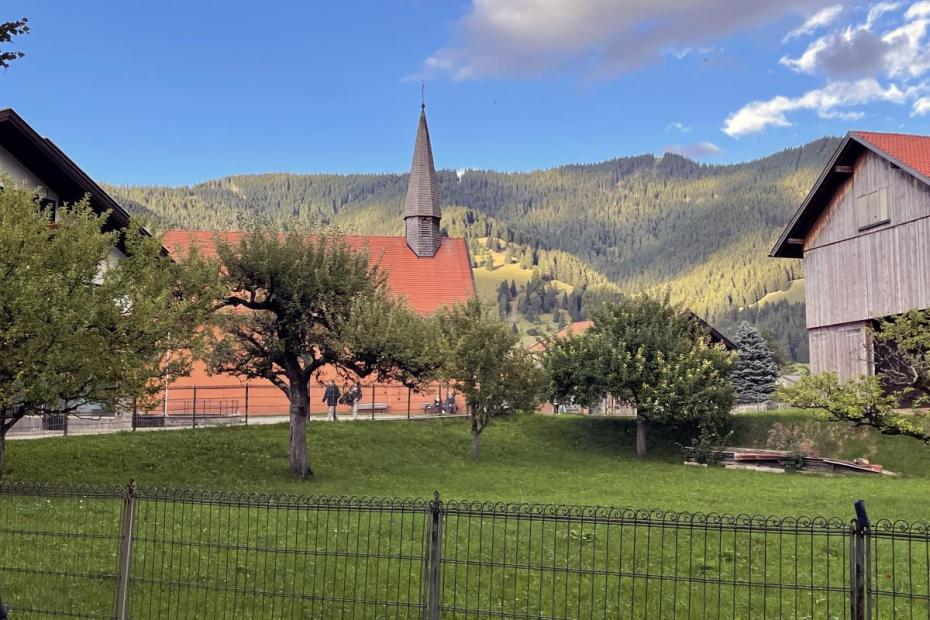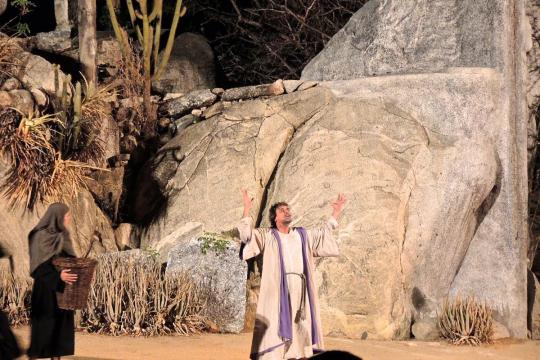For 388 years the people of Oberammergau, Germany, a village of 5,400 people at the edge of the Alps, have performed a Passion Play once a decade in fulfillment of a collective vow made at a moment of desperation. What began as a local act of devotion by means of interpretive embodiment and reenactment grew into an international tourist attraction. The five-hour performance, in a theater big enough to seat most of Oberammergau’s residents, draws roughly 500,000 people per season.1
Only people born in Oberammergau or who have lived there at least 20 years can perform in the play. Remarkably, 1,800 villagers, ranging from young children to 90-year-olds, participate as performers, singers, musicians and extras.2 Even more remarkably, this small-village talent pool yields a performance of high enough quality to draw crowds from as far as the Philippines. When the play is in season, hotels and restaurants in town and nearby are fully booked every night. Tour companies bring in busloads of audience members each day.3
Video footage ©Oberammergau Passion Play 2022
In 2020, in the midst of rehearsals, the play was indefinitely postponed by the COVID-19 pandemic, but from May 14 to October 2, 2022 the villagers finally staged 110 five-hour performances.4 Attendance was down a slight bit, with 412,000 tickets sold, though hotels were full and the season felt like a success to the villagers.5
History
In 1633, in the midst of the Thirty Years’ War, plague reached Oberammergau. Its villagers, seeking a solution after more than 80 people had died, promised that if God would stop the plague, they would perform the Passion every decade. The plague is recorded to have ceased immediately.6 Performances began in 1634 on a stage erected in the yard of St. Peter and Paul Church on top of the burial ground for plague victims. Passion Plays were a common form of devotion at the time in Bavarian Catholic villages.
The Oberammergau play has been updated repeatedly in terms of text and staging to suit late medieval, baroque, enlightenment, and modern sensibilities. In 1674, part of the story was set to music, and in 1680 the performance was shifted to a new cycle, so that it was staged in the first year of each decade. In 1730, tableaux vivants—silent, brief, vivid scenes of actors frozen like baroque paintings to visualize incidents from the Hebrew Bible in order to claim theological connections with the Passion story—were added.7 In 1770, Church and state leaders forbade all Passion Play performances in Bavaria, characterizing it, by Enlightenment standards, as an outdated form of piety, perhaps even a profanation. But in 1780 Oberammergau obtained special permission on the basis of yet another textual revision. Repetition of the ban seemed to doom the tradition, but it was allowed in 1811 under another revision, when much of the current music was composed.8 In 1830, royal permission to perform was conditioned on the play being moved away from the cemetery. Hence it was moved to its current site, near the edge of town. Its organization was subsequently taken over by an elected town committee linked to the parish.
By 1840 the play began to attract a widening circle of media attention. In 1850 it welcomed 45,000 viewers, though the town was still a two-day trip from Munich. The number of performances continued to grow each decade. By 1880, travel agencies like Thomas Cook in London helped increase the season to 40 performances, drawing 100,000 spectators and making it a well-known international tourist attraction. In 1900 a new railway line brought European royalty, a future pope and even more tour groups. After World War I, attendance exceeded 300,000. Hitler twice attended performances and aimed to adapt it to support Nazi goals. World War II prevented the next performance.9
In 1950, despite the legacy of World War II, international tourists visited in larger numbers than ever. From then onward, spectators numbered roughly half a million per season. In the wake of the Holocaust, though, Jewish and Christian leaders began to critique the play for its anti-Jewish framing, which portrayed the Passion as the story of the Jewish people’s rejection of Jesus, without accounting for the Jewishness of Jesus and the apostles. Some rightly questioned how the play helped fuel, and could reinforce, attitudes that enabled the Holocaust. The Vatican II document Nostra Aetate called for rethinking the relationship of the Jewish people as a whole to the Passion, and Munich’s Cardinal Archbishop demanded a revision. Many villagers worked toward a revision, and one was even tried on a trial basis, but in 1990, the changes were rejected in a village referendum and the performance remained little changed.10 More serious rethinking began in the 1990s, under the current director, who in 2022 was awarded the American Jewish Committee’s Isaiah Award for Exemplary Interreligious Leadership.
Women were granted a vote in the village council, which supervises the production, beginning only in 1984. Only in 1990, following a court case, were married women and unmarried women over 35 allowed to participate. By 2000, villagers who were not members of the village’s Catholic or Protestant churches, whether nonbelievers or believers in other faiths, were allowed to participate. In 2022, the deputy director, who also plays Nicodemus, and a performer in the role of Judas are both Muslim sons of Turkish immigrants.
In March 2020, after planning and rehearsals were well under way, the town announced that the play would be postponed due to the COVID-19 virus. In 2022, the town successfully staged a full, if deferred, season.
The play
The Passion Play is a combination of musical performance (a small orchestra and 64-person chorus) and spoken word, staged over the course of five hours with a three-hour dinner intermission. It is entirely in German, except for a few prayers in Hebrew. There are no supertitles. At times there are over 200 performers on the stage, plus occasional donkeys, goats, sheep, horses, camels, and doves.
The play opens with an orchestral and choral introduction.11 Singers dressed in black-and-white plague-era costumes recount the dark events that prompted the villagers to vow that if the plague stopped they would perform the Passion every ten years. The stage then fills with performers reenacting Jesus’ entry into Jerusalem. Jesus is welcomed with Hosannas by the people, but is already perceived as a threat by religious leaders.
The story that unfolds amalgamates the Passion accounts of all four Gospels. Within that narrative, teachings and parables from earlier in the Gospels are re-contextualized to articulate Jesus’ priorities and to make a case for why he was a threat. The script also expands beyond the Gospel texts, adding invented dialogue from the Apostles about what they hoped for from Jesus (primarily theo-political Messianic hopes to overthrow Roman dominion) and from religious authorities and Pilate about how to respond to Jesus. Most controversially for the villagers, the 2022 play re-interprets Judas’ role and intentions.12 Judas is portrayed not as an intentional betrayer but as a follower who wanted to push Jesus harder to fulfill a theo-political messianic vision, but ends up being unwittingly used by the authorities. He even tries to defend Jesus at his trial before the high priests. All the apostles are persistently slow to understand Jesus, who, though certainly radical, calls their attention to trust in God, not politics.
Eleven choral scenes, comprising about a third of the production, are intermittently performed in oratorio form. They mostly recall famous moments in the Hebrew Bible and link them to Jesus’ situation in the next Passion scene. The Jewish people’s worship of the golden calf is evoked before Jesus expels the merchants from the temple; Moses before Pharaoh is compared to Jesus before Pilate, as is Daniel in the lion’s den to Jesus before Annas and Caiphas; the wood that Isaac carried for his own sacrifice by Abraham is compared to the wood of the Cross. Each of the choral scenes is followed by a vivid, rich tableau vivant depicting that Hebrew Bible scene. The saturated colors of the tableaux vivants stand in contrast to the beiges, browns and grays chosen for the spoken word staging.
In recent decades the play has overcome the anti-Jewishness that was built into centuries of its performances, whereby the Jewish people as a whole were portrayed as responsible for Jesus’ crucifixion. The 2022 performance presents Jesus and his disciples as the observant Jews they were. It portrays extended debate among Jewish factions and leaders about how to respond to Jesus. Jesus and the apostles wear kippahs (yarmulkes) and other garb that signals their Jewishness, and Jesus, often called “rabbi,” carries the Torah scroll at one point. At the Last Supper, John leads the Apostles in the Jewish Sabbath blessing, “Baruch atah Adonai, Eloheinu melech ha-olam asher kid’shanu b’mitzvotav v’tzivanu l’hadlik neir shel Shabbat.” “We praise you, Eternal God, Sovereign of the Universe, who makes us holy with mitzvot and commands us to kindle the Sabbath lights.” He asks the question that the youngest person at the table still asks at Passover, “What makes this night different from all other nights?”13
Following a 20-minute crucifixion scene, the play ends with Mary Magdalene, Salome and Mary of Clopas at the empty tomb, with Mary Magdalene announcing in psalm-like joy that Jesus is risen and that she would spread the word. The choir joins in the cries of Hallelujah. Christ is not visible in his resurrection, as he once was in the Oberammergau play, but the play does thereby adhere more closely to the scriptural account.
The audience
The great majority of the people who view the play come on package tours sold by travel agencies, including river cruises, who book up the hotels entirely and buy the best, if not all, of the seats in advance. In addition to travel and hotel, attendees paid for tickets that ranged from €30 to just over €200.
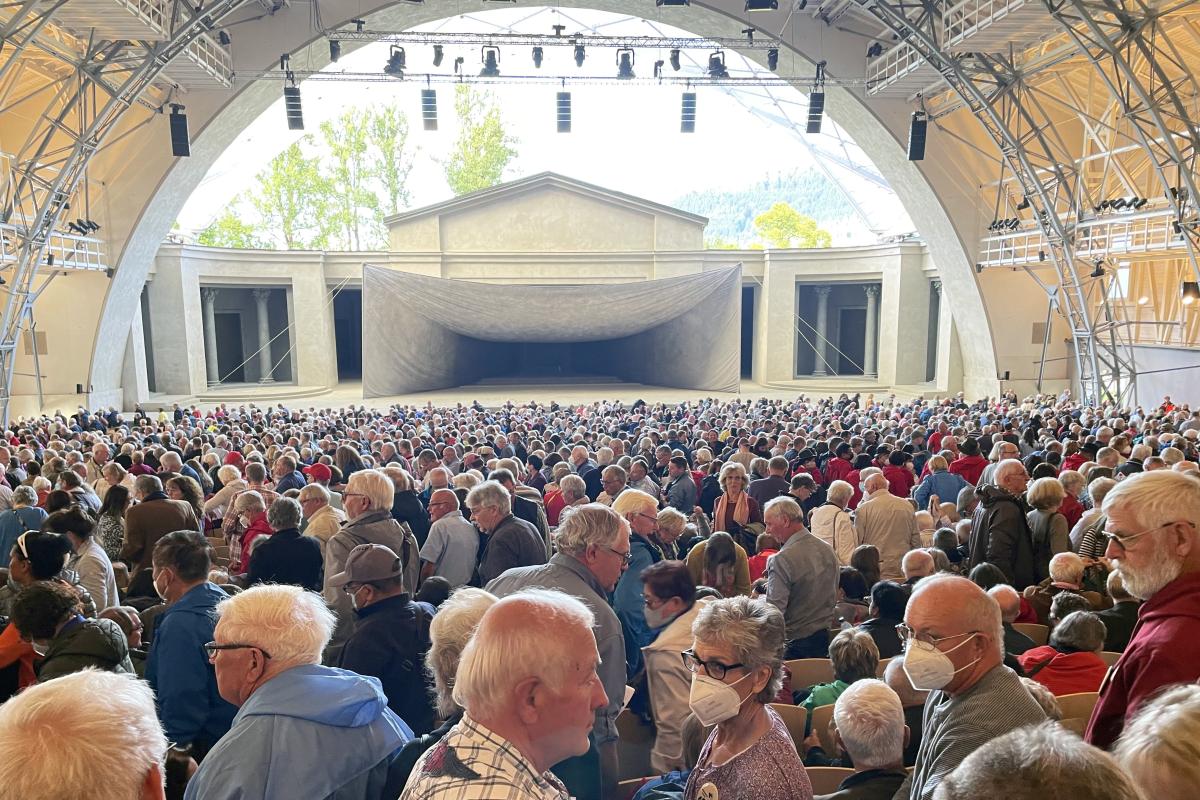
The play largely attracts retirees, something that villagers said has been true for as long as they can remember.
The play’s organizers normally expect only half of attendees to come from German-speaking countries, but this year, perhaps because of COVID, travelers from other countries comprised only 30% of the audience.14 A woman at the play commented that for years Germans did not come, because, “Why bother? The tickets are all sold to foreigners.” The Passion Play office has been working to make tickets available to people from the region, especially to young people, but the audience was mostly in its 60s and 70s (even during school vacation, it was reported) and it had been that way for as long as most people could remember.
The theater sells an English translation booklet, but at 130-plus pages of script, it can be difficult to follow, particularly after dark. Without supertitles, then, non-German audience members do not understand the dialogue and presumably fill in the script with their prior understanding of the story. The visual staging in that case would make more of an impact than the script.
Oberammergau is a beautiful place to stay, though most people can only spend a night or two. The village is picturesque and compact, surrounded by fields and alps. Beyond the play, the old central village is a sort of Christian stage set, mixed in with commercial shops and restaurants. One notable feature is the tradition of Lüftmalerei, pastel frescos, mostly with religious scenes, painted onto the facades of buildings. Oberammergau was also long known as a center for woodcarving, particularly for devotional objects, and the village is still full of small shops selling wooden religious statues, nativity scenes, and more, sometimes alongside secular carvings, though one retired woodcarver reported that the woodcarving business was in decline.
The Catholic and Protestant churches make a variety of outreach attempts in the village to help people explore the faith more deeply, and remain open during the day. Daily Mass and church visits drew a consistent handful of visitors at any given time.
The villagers and the Passion
The Passion Play is clearly a defining aspect of life in Oberammergau. The process of planning and rehearsing the play puts it on villagers’ minds for years. For the 2020/22 production, the municipal council chose the director in 2015. He spent subsequent years planning and choosing performers. In 2018 the bishops of the Catholic and Evangelical churches joined together to preside over a village-wide renewal of the 1633 vows, broadcast on television, when the highly anticipated announcement of the cast was made. On Ash Wednesday the year before the play, the male actors began to let their hair and beards grow.
Having started as a devotional act, how much is it that today, amidst all the other things that it represents? Beyond the performance, how does the Passion Play otherwise define the village in religious terms? Does reenacting the Passion, physically embodying the story over and over, make the villagers more devout in other ways? Or does secular society have a greater hold on them, whatever the family business of the town might be?
Visiting and interviewing villagers provided only limited and sometimes contradictory insight into the religiosity of the village. The questions entail delving into a range of interior beliefs and exterior behaviors that are not always easy to summarize insofar as they are part of the lives of often complex human beings. A visit backstage during the play does offer one experience of disconnect. While one of the most painful struggles might be playing out on stage, other cast members might be enjoying a cigarette or a beer with friends at the back door or in the commissary. But similar disconnects might be found in many contexts, where people leave church and run immediately to other secular activities.
The play mixes commerce and religion of a grand scale, readily inviting questions about whether the business side of the play is what “really” drives this tradition. The play is certainly expensive, and a commercial boon, but villagers point out that it is also expensive and financially risky to put on, and that you can’t run a town on once-a-decade revenue. Other villages in the region that don’t have an event like the play seem no less prosperous than Oberammergau. Asked whether it had become primarily–or too heavily–a commercial enterprise, one interviewee acknowledged that it had a commercial aspect for as long as he had known it, but said that this isn’t what makes it happen. “You don’t get paid enough to make it worthwhile for that. Perhaps if you’re a hotel owner, but few people are. We get paid a little bit for performing, but it’s always less than we would make at our regular jobs.” Participating in the play means taking a leave of absence from work and missing out on summer vacation.15 Practice begins after work daily in January of a given season and performances run five days a week through October. Even in his sometimes skeptical 2000 account of the play, James Shapiro, who engaged many villagers in his research, summed up, “it was clear that it was not about money–the personal sacrifices, in terms of time alone, were too great.”16
Beyond any doubt, interviews with performers and others in the village made clear that the play is deeply meaningful and a source of their collective identity. They are not willing to farm performance roles out to outsiders: it matters to them that they perform it, not someone else.
Performer-interviewees were at ease describing how meaningful it was to belong to this tradition and the community built around the performance. On one level, that belonging comes simply from the time they put in together on a shared project. Second only to school, backstage at the Passion Play was said to be the place for young people to engage each other. A group of men in their early 20s, one of whom played an apostle, talked about the camaraderie that derived from acting together. They mentioned the social opportunities that came with being in the play, including even an “apostles’ party.” Some talked about having a shared identity based not only in joys, but in small sacrifices. Even the experience of growing a long beard and hair, for men, was bonding. “I look terrible,” one said. “I hate them,” said another, wryly. “They make it harder to recognize friends.” Beginning at midnight the night the play closes, one reported, barbers would be open to shear all that hair, a ritual that would also bring them together. Others, when talking about missed vacations, suggested that this loss was for the common good.
On a second, and seemingly deeper level, though, they indicated that their sense of belonging derives from history and tradition. Interviewees could quickly name what roles they and their family members had played over the years, and even who else had played significant roles. They were often animated when they described what it meant to be part of a long-standing, definitive local tradition, fulfilling their ancestors’ collective vow. In this sense, they served as a paradigmatic example of religion as a “chain of memory,” the phrase scholar Danièle Hervieu-Léger coined to characterize religious belief in contemporary Europe.17
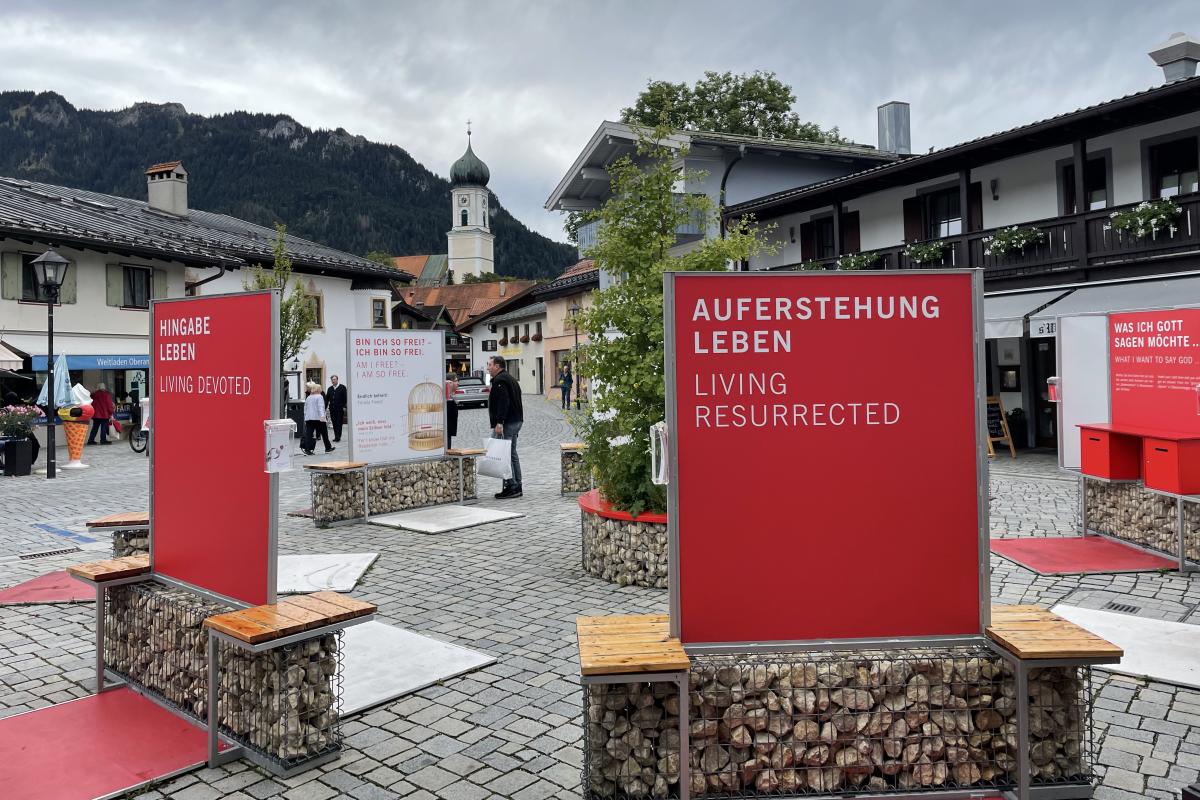
The Catholic and Protestant churches work in tandem to try to engage the Passion attendees in ongoing religious reflection. This display is a joint project. The Catholic parish can be seen in the background.
Asked how many people participate for religious reasons, one actor in his 20s estimated that “about 30%,” but then suggested that it was hard to separate religion from tradition–a characterization that resonates with Hervieu-Léger’s work. He thought that the play has made villagers there more religious than elsewhere, but then hesitated when asked about specific ways.
Most interviewees thought that the play did not make villagers here religiously that much different than in other villages of Bavaria. The parish priest indicated that unlike other parts of Bavaria, parishioners of all ages here knew the Gospel well. But he agreed with most lay interviewees that it did not make them individually into more committed Catholics by other measures like Church attendance, prayer or devotions. Contemporary culture, he and others agreed or implied, was ultimately more influential of people than the daily acting out of the Passion.
As is true in many parts of Germany, a significant number of villagers have gone to state authorities to declare themselves independent from any religion (and therefore free of a longstanding tax to support their church). The parish priest was unsure of the exact number, because some people fall off the rolls by virtue of moving temporarily, but shared that this was a village that was not so much post-Christian as skeptical about their need for the church. “Many people would rather pray in the mountains,” he said. One cause mentioned was a serious sex-abuse scandal centered at the nearby monastery of Ettal, but others were leaving before that (as they have from the Protestant Church there). The distancing from the Church, the pastor said, was not particularly a phenomenon among young people, but people of all ages.
But it would also be a mistake to see even non-Church committed villagers’ engagement with the Passion as the mere performance of lines given to them. People had a stake in how the story was told. This included but also extended beyond the debates recounted above about the Jewishness of Jesus. Interviewees alluded to debates in the village about how to tell the story on stage. Some villagers apparently sat out participating in 2020/22 because of the re-interpretation of Judas’ motives in this year’s telling, and made their unhappiness known.
The process of interpreting, editing, rehearsing, and voting over the production is different than reading a fixed lectionary text each year during Holy Week. Actors say that they are called upon to think about its meaning, including with help from theologians, and to interpret the play into being, though the final dramatic interpretation belongs to the director. One 90-year-old actor could recount off the top of his head a whole range of interpretive changes since he first acted in it in 1950. All interviewees said that the experience had made them think deeply about Jesus’ life and Passion, but all found it difficult to say how their thoughts had changed. It was not clear whether this difficulty was because it was a challenging question or because they were reticent to talk about personal belief.
James Shapiro reported in 2000 that “ten of the younger actors playing major roles had sat and talked late into the night about the fact that they did not believe, really believe, in the Resurrection of Jesus. This struck me as a characteristic Oberammergau moment: only here do people who have lost their faith spend so much time agonizing over it.”18
- 1Official counts ranged from 450,000 to 530,000 per season from 1960-2010. The theater seats 4,400 people.
- 2Exceptions are made for the priest of the Catholic parish of St. Peter and Paul and the minister of the Evangelical church, both of whom perform in minor roles. This number is actually significantly lower than usual. An additional 500 adult villagers were scheduled to participate in 2020 but were unable to reschedule for 2022 because they were no longer able to make alternate work arrangements.
- 3In the years between the Passion Plays, the theater is home to other productions, which bring in tourists and help cultivate local talent.
- 4During the days when this account was written, in early September 2022, the theater was nearly full, but not sold out, though all the hotels in town were fully booked. The account is based on attendance at the play and a dozen interviews of participating townspeople in formal and informal settings, as well as statistical information provided by the Office of the Passion Play. In 2022, 104 of the productions were for ordinary ticket holders, while the dress rehearsals were open to people ages 16-28.
- 5The 2022 data is from the Passion Play office, “Press release on the last performance of the 42nd Oberammergau Passion Play,” September 27, 2022.
- 6The broad outline of this history is reproduced in many settings. A good deal of what follows derives from the historical timeline displayed in the Passion Play theater. For a popularly accessible account of the history and the village dynamics preceding the 2000 staging, see James Shapiro, Oberammergau: The Troubling History of the World’s Most Famous Passion Play (New York: Vintage, 2001). The historicity of the origin narrative is complicated, as Shapiro recounts (104-11), though it is clear that there was a plague and that the play was performed in 1634. The parish church makes the plague-era death registry available for viewing during the Passion Play season.
- 7That theological framework and the choices of Hebrew Bible texts has changed over time, including in recent decades.
- 8The music, like the text and staging, has been revised over time, but stylistically it hearkens to the early 19th century. Engravings of the staging show that it was quite elegant even before the move from the church graveyard.
- 9For more on that highly staged visit and its impact on the village, see Helena Waddy, Oberammergau in the Nazi Era: The Fate of a Catholic Village in Hitler's Germany (Oxford, 2010). Among those I interviewed was a man who was an infant at the time of Hitler’s visit. He volunteered insight on life in town during Nazi era, admitting that he thought as a boy that Hitler was a good man, “But what did I know? That was all that we were told.” The first Passion Play he acted in was in 1950, and he still acts in the play as an extra.
- 10 The “blood curse” (Matthew 27:24–25), the instance when Pilate washes his hands and the people reply, “His blood be on us and on our children!” was apparently not removed until after 1980. Michael Paulson, “‘It’s My Tradition Too’: A Town’s Centuries-Old Passion Play Evolves,” New York Times, August 24, 2022. For an extended account of the debates from 1950-2000, see Shapiro, Oberammergau, 1-44, 73-100.
- 11This description refers to the 2022 play, as seen on September 8. The opening choral scene, script, and tableaux vivants all differ from prior years.
- 12Several interviewees described this to me as a major source of contention and indicated that some villagers had stayed away from participating because of it.
- 13 It bears noting that the props used are a-historical. Jews did not wear kippot in Jesus’s time, a menorah would not have been at the Last Supper, but here they make a theatrical point. For more on the transformation, see A.J. Goldmann, “How Hitler’s Favorite Passion Play Lost its Anti-Semitism,” The Atlantic, August 4, 2022 and Peter A. Pettit, “The Success of this Passion,” Sightings, September 23, 2010. The American Jewish Committee also has resources available on the transformation from its committee’s perspective at https://www.ajc.org/OberammergauPassionPlay/Resources. Special thanks to Rev. Peter Pettit and Rabbi Noam Marans, who were part of the 2022/23 AJC Academic Advisory Group, for their personal insights on the process.
- 14 “Press release on the last performance of the 42nd Oberammergau Passion Play,” Office of the Passion Play, September 27, 2022.
- 15A small number of roles involve only evening performance now, enabling more villagers to participate.
- 16Shapiro, Oberammergau, 198.
- 17 Danièle Hervieu-Léger, Religion as a Chain of Memory (New Brunswick, N.J.: Rutgers University Press, 2000).
- 18 Shapiro, Oberammergau, 201.
